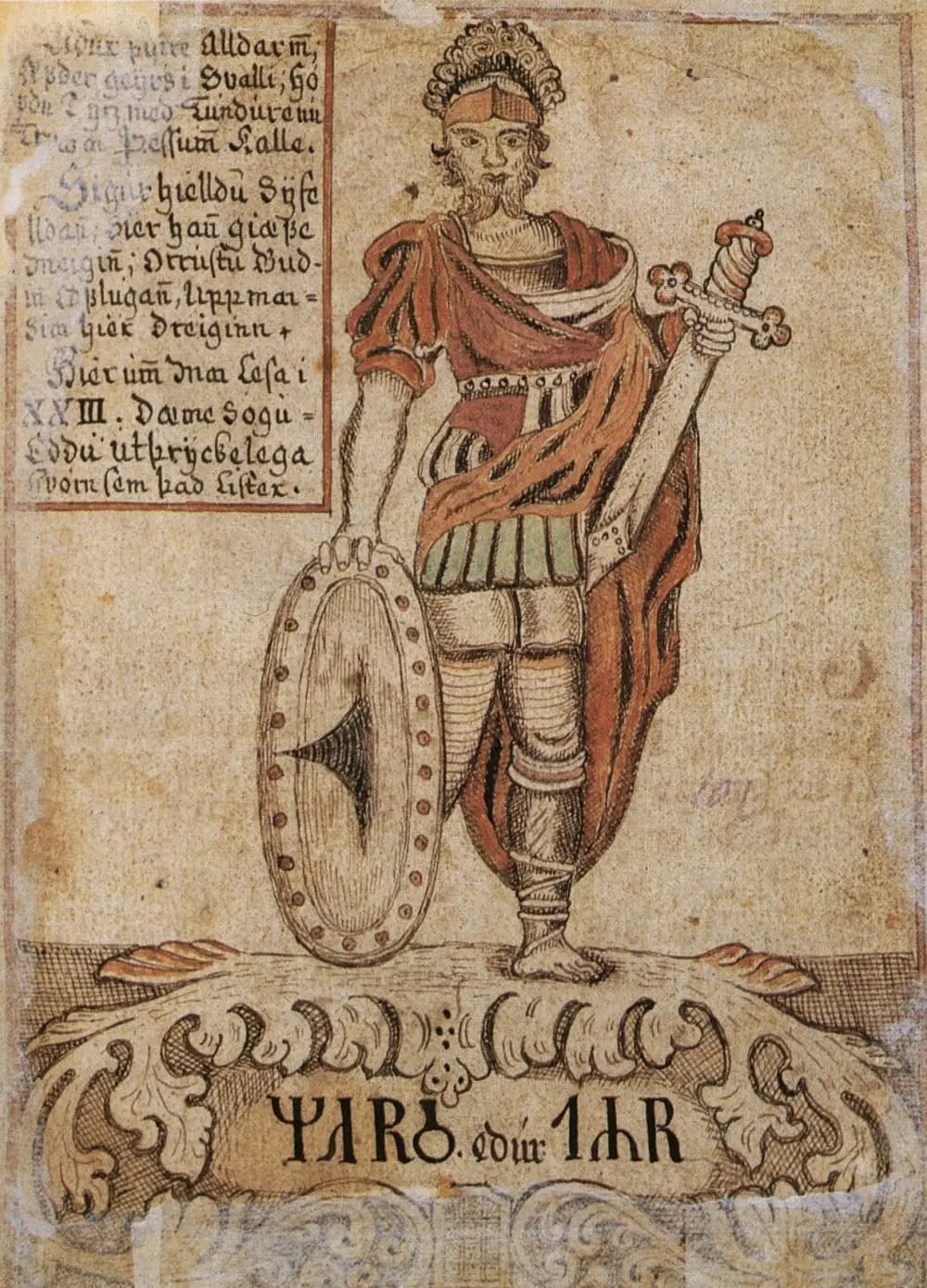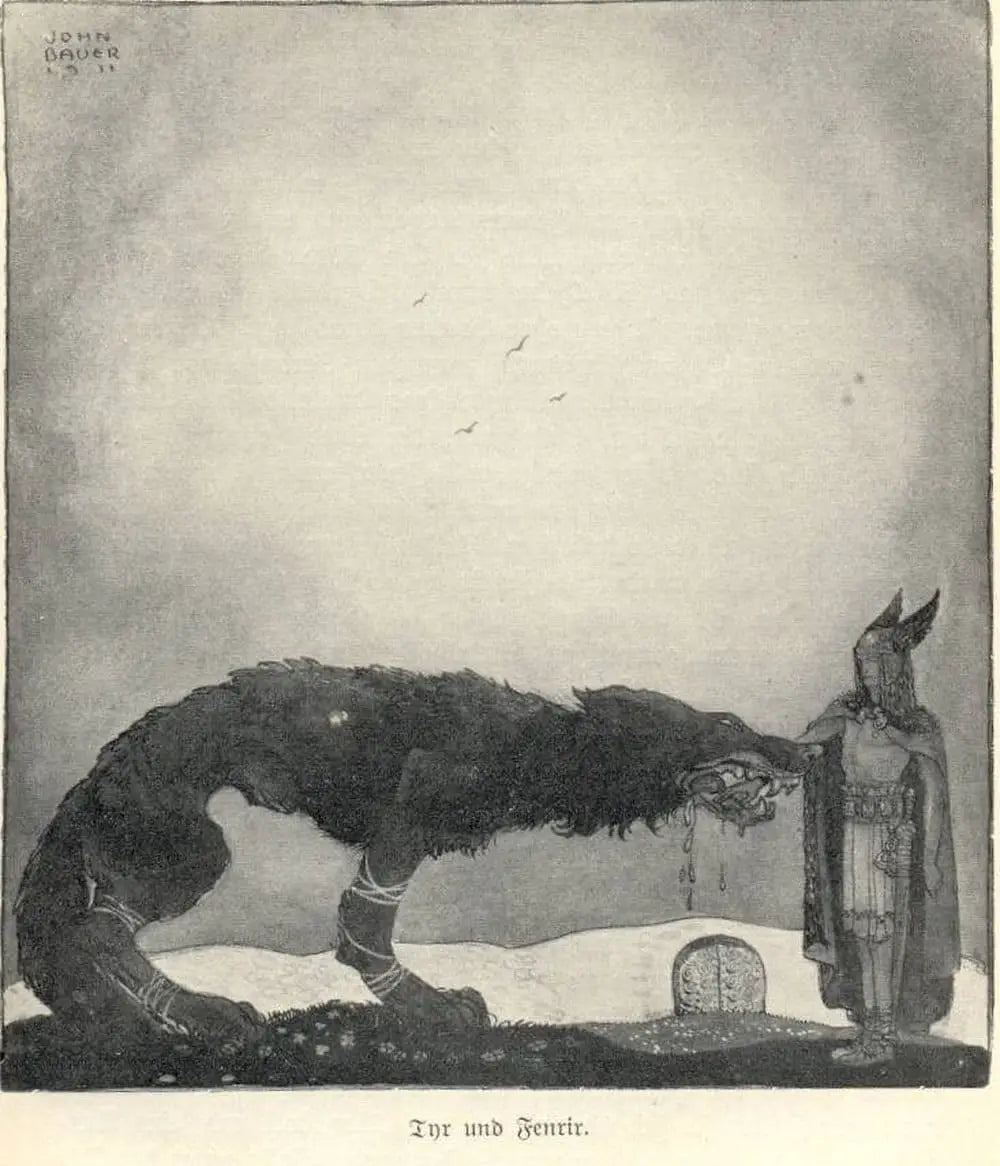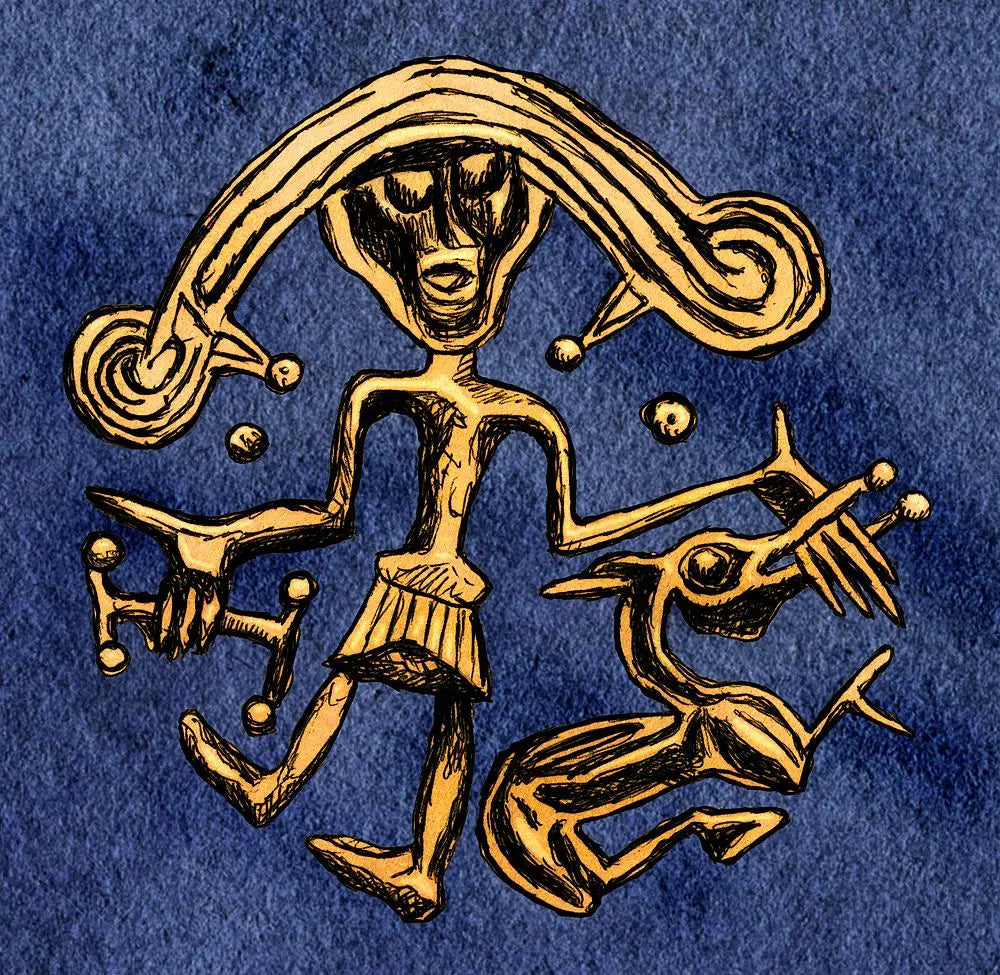Your Cart is Empty
Menu
-
- Shop by Type
- End of Line Sale Items
- New In
- Viking Gifts Under $30
- Hand Forged Axes
- Silver Viking Jewelry
- Stainless Steel Jewelry
- Cremation Jewelry
- Necklaces and Pendants
- Hand Carved Wooden Pendants
- Kings Chains
- Viking Drinking Horns
- Pendant Chains
- Rings
- Bracelets
- Earrings
- Beard Beads and Beard Rings
- Collectables
- Ceramic Mugs
- Street Wear
- Horn Jewelry
- Bronze and Pewter Jewelry
- Shop by Theme
- Viking Axe
- Celtic Jewelry
- Dragon or Serpent
- Viking Raven
- Wolf / Fenrir
- Rune Jewelry
- Odin Jewelry
- Ram / Goat
- Shieldmaidens / Lagertha
- Sword, Spear or Arrow
- Thor's Hammer / Mjolnir
- Tree of Life / Yggdrasil
- Helm of Awe / Aegishjalmur
- Triquetra or Triskelion
- Valknut / Knot of Slain
- Vegvisir / Viking Compass
- Veles / Bear
- Blogs
- Help
-
- Login

Tyr

Tyr is one of the Aesir gods in Norse mythology. The minor role of Tyr in the surviving Norse myth literature suggests that in the late pre-Christian period, when the written tradition came into being, he was in the shadow of Odin and Thor. Moreover, the place-name material indicates that in the Viking Age Tyr was mainly worshipped in Denmark. He is depicted as a god of justice and war.
In the Viking Age he was a lesser mythological figure, but in earlier times he had greater religious and mythological significance. Tyr is also known from other Germanic mythologies; in Gothic he was called Teiws, in Anglo-Saxon Tīw and in Old German Ziu.
His family ties are uncertain; according to Snorre Sturlason's Younger Edda, Tyr is the son of Odin, while according to the Edda poem Hymerskvadet he is the son of the giant Hymer.
The most important myth about Tyr is the binding of the giant wolf Fenrir. It describes how Tyr lost his right hand when he put the monster in chains.
Etymology
The various Germanic names for Tyr all derive from Proto-Germanic *Tîwaz (el. *Tē₂waz), related to the reconstructed name of the main god of Proto-Indo-European religion, *Dyéus (el. *Dyáus).
This derives from Proto-Indo-European *d_i~e_us (= day/heaven), which according to Folke Ström suggests that *Tîwaz was the Germanic name for the sky god.
This interpretation has led to speculation that he was the most important god in the North, as a parallel to Zeus and Jupiter, both the supreme god in each pantheon as sky and ruler god.
The word týr was the kenning for "god" in Norse; in Icelandic texts the word týr is the root word for kennings for other gods, e.g. Sigtýr (= God of Victory) and Valtýr (= God of Valens, God of the Campaign), both of which were nicknames for Odin. Reiða týr was the kenning for Thor, and is even known in the plural form tívar.
Tom L. Mackay interprets the inscription on the Negau helmet as harigasti teiva (Urgerman: *harjagastiz *teiwaz), where the first word consists of the two elements hari- and -gasti, while teiwaz is proposed as an older form of Tyr.
It has also been suggested that he is related to the older deity Tuisto, mentioned by Tacitus in Germania.
Characteristics

Tyr is known from the oldest sources of Germanic religion. From South Germanic sources we can see that in those areas Tyr functioned as a god of war, often identified with the Roman god of war Mars. It gave its name to Tuesday, the day of the week, which in Latin was called dies Martius.
The same is seen in other Germanic languages, Swedish Tuesday, English Tuesday, Germanic Zischtig. In German the day is called Dienstag, which derives from the name Mars thingsus, possibly a romanised version of Tyr/Tiwaz. His most important attribute was the sword, and warriors carved e.g. T-runes into swords.
In 1935 Jan de Vries proposed Tyr as the god of justice and of property. This view is supported by the fact that in Norse myths he is associated with the court, trial and law.
Tyr is almost absent from the Swedish, Norwegian and Icelandic place-name material. On the other hand, the name of another god, Ullr, occurs frequently in that area, and practically not in Denmark. Ullr, like Tyr, has been interpreted as an older sky god that had lost its importance in the Viking Age. On this basis, Folke Ström has suggested that Ullr was simply one of the names of the older Norse sky god, i.e. that Ullr was the North Scandinavian parallel to Tyr.
A text apparently used in connection with the baptism of Germanic pagans, and preserved in the Vatican, mentions a triad of devils that the pagan was asked to ward off: Odin, Thor and Saxnot. It is assumed that these are the three most prominent pagan gods, and it has therefore been suggested that Saxnot is a variant of Tyr.
In the Icelandic works Old and Younger Edda there are several references to the central Tyr myth, describing how the gods had the wolf Fenrir bound. The beast had grown so large that only Tyr dared to feed it, and no chain could withstand the beast's powers until some dwarves made the chain Gleipnir.
It looked like a silk cord, but was made of six fictitious things: the sound of a cat's footsteps, a woman's beard, the roots of a mountain, the sinews of a bear, the breath of a fish and the saliva of a bird. Fenrir sensed the gods' cunning, and so demanded that one of them put his hand in its mouth as a pledge.
Tyr, described as wise and courageous, agreed to the offer. When the wolf could not get free, all the gods cheered, except Tyr, for he lost his hand.
In Snorri's tale of Ragnarok, it is told that it is Tyr's fate to meet the dog Garm, Hels's hellhound. It may have originally been identical with Fenrir, so that the final battle can be seen as a continuation of the above myth of the bound wolf. In the two versions of Völuspá, however, he is not mentioned in connection with Ragnarok.
In Lokasenna, Tyr is mocked by Loki for having fathered a child with his wife with impunity. This is the only known reference to Tyr's marital status, just as the child's possible identity is completely unknown. Anders Bæksted has suggested that this relationship is something the poet himself invented.

In Hymiskviða, the giant Hymir appears as Tyr's father. In other texts, the kenning "Hymir's lineage" is used for the giants. Tyr's relationship to the giants is not mentioned elsewhere, and in the Younger Edda he is described as Odin's son.
Bæksted believes that this confusion is linked to Tyr's declining status in the Viking Age, when the myths about him had gradually been forgotten. His mother's name is not known, but she is described in Hymiskviða in a way appropriate for a goddess. In this myth, Tyr is compared to Thor. However, the god of thunder proves to be the strongest, as only he is able to carry Hymer's cauldron.
Tyr and Fenrir

Not surprisingly, it is Tyr himself, according to a first version, who fights Fenrir, the giant wolf, offering him an arm to maul (which he thus loses forever) in order to get him close enough to bound him.
A second reconstruction of the story has it that the wolf, son of the god Loki and the giantess Angerboda, was so threatening to the Aesir that they were induced to chain him in a distant place under the pretense that they wanted to subject him to a test of strength.
Despite the work of Odin's smiths, however, twice the mighty wolf managed to break free, forcing the father of the gods to resort to the arts of the dwarves who lived in Nidavellir: the supreme god then prepares a seemingly fragile snare and again challenges the wolf, who, sensing the deception, demands by way of a pledge a hand in his jaws during the enchainment; it is Tyr himself who sacrifices himself, losing his arm but allowing the fierce wolf to be chained.
Tyr and Thor
Tyr appears in Hymiskviða in the Old Edda, where he helps Thor to get a brewing vessel big enough to brew beer for all the gods at once. The gods wonder where there is a large enough brewing vessel, and Tyr says that Hymer out in Elivåger, where heaven and earth meet, has a cauldron a mile deep.
They cannot get it by force, but by cunning. Thor harnesses the goats to the wagon, and takes Tyr with him. In the giant's courtyard, Tyr's mother welcomes them, fair-skinned and decked with gold jewels.
There Tyr also sees his grandmother and her no fewer than 900 heads. They wait for Hymer to return home, his beard full of ice. Tyr's mother tells him to be glad of the visit; her son has come with a guest.
Hymer has three bulls slaughtered, and Thor puts two of them to death. The giant remarks that if they are to be fed next day, they must go to sea for food. There Thor hooks the Midgard Serpent, but also several whales, and Hymer lets them borrow the kettle. Tyr, however, fails to move it, so Thor must take it over and fight the giants, who come rushing after it before the kettle reaches Aegir's hall.
Tyr's Cult

The earliest evidence for the god is found in the Gothic "Tyz," although the "Teiw" found on Negau's helmet may be a likely reference to Tyr, rather than a generic god, and predates Gothic (and Runic) by many centuries.
The cult of Tîwaz at some point was superseded by that of Odin and Thor in the period before the barbarian invasions. A reference to these ill-defined cults in the Germanic religion can be seen from the fact that Thor is quintessentially the god of lightning for this religion, just like most of the gods that can be identified with Tyr in other religions: Zeus, Jupiter, etc. This may suggest that all deities derived from the Proto-Indo-European one were in ancient times possessors of thunder and its attribution to Odin's son occurred only in more recent times.
However, he represents a warrior-god different from the Greek Ares, more impetuous and youthful; in Norse mythology the figure most similar to this model of the war god is probably Thor, described without doubt as the strongest of all the gods, and this fact could signify a further connection between these two deities, although Tyr embodied more of the dual figure of the god of war, justice and law, since he is presented as the model of a mature, experienced, thoughtful warrior ready for personal sacrifice.
A further connection between the Norse deity and the Proto-Indo-European deity can be found with the god's similarity to his Vedic counterpart Indra: indeed, both deities have the role of leadership emphasized during times of war; although this view is accepted, however, Odin is described as the omniscient god of the Norse pantheon and particularly of the Aesir lineage.
The philologist Jacob Grimm speculated that Tyr's wife, mentioned stanza 40 of the poetic Lokasenna Edda without ever naming her, can be identified with Zisa, a female deity whose worship was attested among the Suebi.
The god Tyr is credited with the English name for the day Tuesday: the Germanic peoples, noting similarities between the Romans' god Mars and their own god of war, took the idea of the day Tuesday and borrowed it by affixing the name of their own god.
